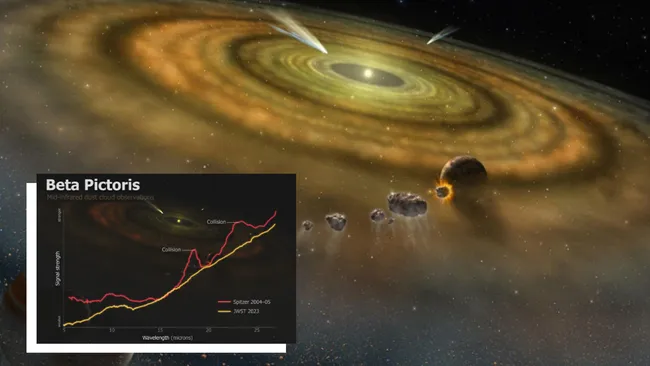James Webb Space Telescope spots asteroid collision in neighboring star system
"What we could be seeing here is basically how rocky planets and other bodies are forming in real time."
 |
| (Main) an illustration of the star system Beta Pictoris (Inset) a graph indicating the detection of an asteroid collision in Beta Pictoris by the JWST (Image credit: NASA/FUSE/Lynette Cook) |
The James Webb Space Telescope (JWST) has observed evidence pointing to asteroids colliding in a neighboring star system, in space.com. Resultant dust kicked up by the collision has a mass equal to around 100,000 times that of the asteroid that killed the dinosaurs.
The asteroids were seen smashing together in Beta Pictoris, a star system located about 63.4 light-years from the solar system. This star system is known for its relative youth; it's just around 20 to 25 million years old, which makes it a celestial infant compared to our 4.6 billion-year-old solar system. The fact that Beta Pictoris is still in the throes of early planet formation means the JWST's observation of colliding asteroids within this star system could shine a light on the volatile processes that shaped neighborhoods like the solar system in their infancy.
"Beta Pictoris is at an age when planet formation in the terrestrial planet zone is still ongoing through giant asteroid collisions, so what we could be seeing here is basically how rocky planets and other bodies are forming in real time," team leader Christine Chen, a Johns Hopkins University astronomer, said in a statement.
How the JWST saw changes around Beta Pictoris
Though they're relatively close, the distance between the solar system and Beta Pictoris is large enough to make directly spotting asteroids colliding in the latter incredibly difficult. Beyond distance, in fact, you'd need to catch a collision amid the dusty torus of gas and dust around Beta Pictoris' young star, called a "protoplanetary disk."
To make this detection, Chen and colleagues compared new data from the JWST with observations collected by the Spitzer Space Telescope between 2004 and 2005. This revealed significant changes in the energy signatures of dust grains around Beta Pictoris, with a particular focus on heat emitted by minerals commonly found around young stars as well as on Earth. They're called "crystalline silicates."
The detailed measurements taken by the JWST allowed the team to look for dust particles in the region of Beta Pictoris that Spitzer previously probed. They found no trace of particles seen by Spitzer two decades ago. This implied that a cataclysmic collision between asteroids or other objects around Beta Pictoris had taken place around 20 or so years ago. Such a smash-up would have pulverized these bodies, turning them into a shower of particles as fine as powdered sugar.
"We think all that dust is what we saw initially in the Spitzer data from 2004 and 2005," Chen said. "With the JWST's new data, the best explanation we have is that, in fact, we witnessed the aftermath of an infrequent, cataclysmic event between large asteroid-size bodies, marking a complete change in our understanding of this star system."
Asteroid-collision dust is absent in the JWST images because radiation from the star Beta Pictoris has since dispersed any such particles. The emissions seen by Spitzer 20 years ago represented the beginning of this process, when the dust was being heated by stellar radiation and emitting thermal energy. Moving away from the central star has also caused the dust to cool, meaning its thermal emission is no longer occurring.
Spitzer's observations of the region had previously been assumed to be the result of small bodies around Beta Pictoris grinding down and steadily replenishing the dust over time. However, the JWST data indicates that this dust actually isn't being replenished when it is kicked away by the central star.
The relative proximity of Beta Pictoris, known to host two young exoplanets, and its youth has made this planetary system a prime target for astronomers attempting to understand the processes that govern planetary formation.
"The question we are trying to contextualize is whether this whole process of terrestrial and giant planet formation is common or rare, and the even more basic question: Are planetary systems like the solar system that rare?" team member Kadin Worthen, a doctoral student in astrophysics at Johns Hopkins, said in the statement. "We're basically trying to understand how weird or average we are."
This new research highlights the JWST's capability to investigate the intricacies of planetary systems and extrasolar planets, or "exoplanets." The $10 billion space telescope could help explain why planetary systems sometimes form like the solar system and, other times, adopt varying morphologies.
The JWST could also help astronomers discover how early turbulence around stars impacts the atmospheres, water content and other key aspects of habitability for their planets.
"Most discoveries by JWST come from things the telescope has detected directly," team member Cicero Lu, a former Johns Hopkins doctoral student in astrophysics, said in the statement. "In this case, the story is a little different because our results come from what JWST did not see."
The team presented their resents on Monday (June 10) at the 244th Meeting of the American Astronomical Society in Madison, Wisconsin.






Коментарі
Дописати коментар